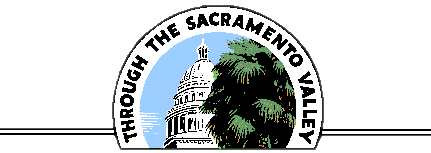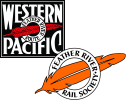WESTERN PACIFIC'S MILL GONDOLAS
When the Sacramento Northern Railway began serving the U.S. Steel rolling mill at Pittsburg, California, in 1930, both they and the Western Pacific were hardly prepared for the traffic. Neither the SN nor the WP owned a single mill gondola. Most of the steel traffic was carried in WP's fleet of 1,100 composite GS gondolas (4101-4500 and 5301-6000), and in cars contributed to the pool by the Denver & Rio Grande Western. This scratch fleet was barely adequate to handle the traffic in the 1930s, and totally overwhelmed by the huge demands of World War II that soon swamped all three lines.
Even before the war, U.S. Steel was making heavy shipments from its Utah plants to their Pittsburg works, and other West Coast customers. This traffic moved via the D&RGW, WP, and finally if to Pittsburg, over the SN. In 1944, the U.S. government built a huge new blast furnace and mill complex at Geneva, Utah, (operated under lease by U.S. Steel). Steel traffic to the West Coast soared, and remained strong when the country shifted to a peacetime economy.

The traffic boom caused a critical gondola shortage for the WP. The situation eased somewhat when the U.S. Government leased a fleet of mill gondolas to the D&RGW. The WP added 100 of their own 52-foot, 6-inch mill gondolas from Mt. Vernon Car Manufacturing Company in October 1945 (6501-6600). Then in 1947 the government transferred their mill gondolas from the D&RGW to the Alaska Railroad, and car shortages returned. Finally in May and June 1949, Greenville Steel Car Company built 200 more 52-foot, 6-inch mill gondolas (6601-6800), and 50 gigantic 65-foot, 6-inch cars (9001-9050) for the WP. Many of these mill gondolas were fitted with temporary wooden cradles for coil service when this traffic boomed after the war years. Between 1956 and 1958, 100 of the 6601-series cars were rebuilt with permanent steel coil racks and renumbered 6301-6400.
An interesting photo on page 326 of David F. Myrick's RAILROADS OF NEVADA AND EASTERN CALIFORNIA (Berkeley: Howell-North, 1962) shows part of a train rolling through Elko, Nevada, about 1950. At least three of the eight visible mill gondolas can be identified as WP cars, two from the 6501 or 6601 classes and one a 9001-class 65-footer. What is most instructive is that all the gondolas appear to be carrying just 3-6 coils in each end only over the trucks. Nearly 50 percent of every car is empty. This suggests that a small number of coils loaded the cars to their 70-ton capacity, or the cars were loaded light to keep concentrated weight off the structurally weaker center section. Whichever the case, the mill gondolas had a lot of useless weight that was being dragged across more than 1,000 miles of Utah and Nevada deserts, a costly waste of fuel. This problem did not go unnoticed by the WP's engineering department.
By 1951, the WP again needed more gondolas for the growing coil traffic. Once more they turned to Greenville, this time for a novel fleet of light-weight cars. To save dead weight, the gondolas were only 29-feet, 4-inches long inside, eliminating the useless center section with its fishbelly sides and heavy underframe. The bantam cars still weighed in at 46,800 lbs, but saved 11,900 lbs over their larger sisters. They were delivered in September 1953 and numbered 6401-6500. In 1956 all were fitted with permanent steel coil racks, replacing earlier expendable wooden cradles. The cars were used exclusively between Geneva and Pittsburg, the coil cradles and racks making them unsuitable for any other loading.
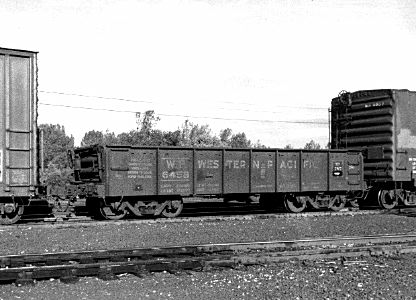
Additional fuel savings were realized by fitting Timken roller bearings into the 6401-series cars' ASF A-3 trucks, the first such large-scale application on the WP. In keeping with railroad management thinking of the time, roller bearings were only for cars in captive service. Roller bearings were much more expensive than plain bearings. It made little economic sense to put them on cars in general interchange, which would spend most of their lives saving fuel on other railroads. When delivered, the bantam cars proudly carried the famous Tinken "Roller Freight" herald above their right-hand trucks.
The short gondolas had one other curiosity: they were equipped with drop ends. After coming up with such a novel, economical design, one is left to wonder why extra money was wasted on such a useless feature. It has been suggested that the drop ends allowed the short gondolas to be used as idler cars for long loads of structural steel, but there is no evidence this actually happened. The drop ends were noted in the WP's equipment diagrams and Official Railway Equipment Register entries up into the 1960s. On cars your editor examined in 1978, a bolted steel strap on the top of the bulb angle held the ends and the sides together at each corner. It is doubtful if the drop ends were often used, or even if they ever were used at all. The coil cradles and racks would have prevented the ends from being dropped to floor level.
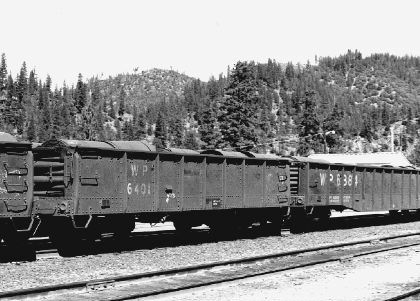
There was never a repeat order for the little gondolas. Apparently they did an adequate job of carrying the coils, though they continued to be supplemented by the longer gondolas. When the WP and SN added more mill gondolas in 1958, they opted for the usual 53-foot inside length. By the 1960s, covered gondolas were preferred by shippers. Between 1957 and 1964, 24 of the 6501-class cars and two of the 9001-class were fitted with covers. No 29-foot cars received covers. In 1970 and 1973, additional covered and uncovered mill gondolas were purchased from Thrall and Maxon, but the trend by then was toward specialized 100-ton coil cars with covers.
Aside from the coil racks, the only other major change to the bantam gondolas in their nearly 30-year service life was renumbering 25 cars into the 4401-4425 class in 1978. Whether these were merely refurbished or were modified with some new type of rack is not clear. They were still used for coils as my picture of 4412 shows. These 25 cars became Union Pacific's G-70-16 class with the merger and kept the same numbers, some receiving freight car red paint. As of 2003, there were still four cars from this series in service on the UP, however they were by then used for maintenance duties. The remaining cars in the original series were scrapped by the 1980s.
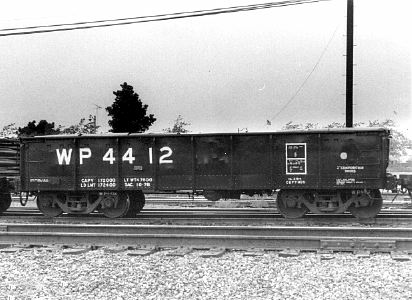
It has often been claimed that the WP's 29-foot gondolas were unique in the railroad industry. Apparently this is not so. Some cars very similar to the WP's were among the motley collection of relics operated during the 1990s in scrap service on the M-K Metals in-plant railroad at Ashland, Kentucky. They also appear to be around 29 feet long, but seem to have a different rib pattern on their sides. Their origin is unknown.
